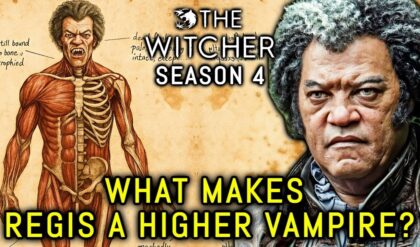Shocker: Netflix’s ‘Adolescence’ Isn’t Woke After All—It’s the Oldest Story Ever Told, Repackaged for a Modern Audience
Netflix’s latest teen drama, Adolescence, has been making waves—and not always for the right reasons. Branded as “Wokeflix” by detractors and accused of pushing a progressive agenda with its tale of a 13-year-old “incel” murderer, the series has sparked heated debate since its debut. But what if the critics have it all wrong? Far from being a bleeding-edge commentary on modern woes, Adolescence might just be the oldest story in the book—a timeless narrative of sin, downfall, and societal failure, dressed up in contemporary clothes. Beneath the buzzwords and outrage lies a plot that echoes ancient myths, classic literature, and even biblical archetypes, proving that some tales never truly go out of style.
The show follows Jamie Miller, a 13-year-old British boy who spirals from a quiet, awkward kid into a killer after being radicalized by online misogyny. On the surface, it’s a story ripped from today’s headlines: youth violence, internet echo chambers, and the specter of toxic masculinity. Yet peel back the layers, and Adolescence reveals itself as something far more primal—a cautionary tale about innocence lost, the corrupting power of external forces, and the consequences of neglecting the vulnerable. Far from woke, it’s a throwback to storytelling traditions that predate Netflix by centuries.
The Plot: A Modern Spin on an Ancient Tale
At its core, Adolescence is deceptively simple. Jamie, a bright but socially isolated teen, lives in a nondescript British town with his well-meaning parents. His life takes a dark turn when he’s drawn into the online “manosphere,” a digital underworld of resentment and rage. By the series’ climax, he’s arrested for murdering a female classmate—a shocking act that leaves his community reeling. Critics have fixated on the “incel” label, decrying it as a woke buzzword that doesn’t fit a 13-year-old. But look closer, and the story transcends its modern trappings.
This isn’t a tale of 21st-century radicalization—it’s a retelling of humanity’s oldest narrative: the fall from grace. Jamie is Adam, tempted by the forbidden fruit of toxic ideology. He’s Cain, driven to violence by envy and isolation. He’s Icarus, flying too close to the sun of unchecked freedom. The internet, in this reading, isn’t a newfangled villain but a stand-in for the serpent, the storm, the siren’s call—age-old forces that lure the naive to their doom. Adolescence doesn’t invent a woke crisis; it recycles a story as old as civilization itself.
Not Woke—Just Classic
The “woke” label has dogged Adolescence from the start. Detractors argue that its focus on misogyny and online radicalization reeks of progressive pandering, a bid to signal virtue to a liberal audience. Yet this criticism misses the mark. Woke narratives, by definition, seek to challenge norms, expose systemic injustices, or amplify marginalized voices. Adolescence does none of that. Jamie isn’t a victim of oppression—he’s a middle-class kid with loving parents. The show doesn’t critique power structures or call for revolution; it simply watches a boy unravel. If anything, it’s conservative in its bones—a warning about moral decay and personal responsibility.
Compare it to the classics, and the parallels leap out. Take Sophocles’ Oedipus Rex: a man undone by fate and his own flaws, blind to the forces steering him toward ruin. Jamie’s descent mirrors Oedipus’—both are shaped by external influences they can’t fully grasp, both meet tragic ends. Or consider Shakespeare’s Macbeth, where ambition and manipulation drive a once-honest soul to murder. The witches whispering in Macbeth’s ear aren’t so different from the online forums goading Jamie. Even the Bible offers a template: the story of David and Bathsheba, where desire festers into sin, could be Jamie’s arc in a different era.
The Timeless Themes at Play
What makes Adolescence feel ancient isn’t just its structure—it’s its themes. The corruption of youth is a motif as old as storytelling itself. In Greek mythology, Phaethon begs to drive his father’s sun chariot, only to crash and burn when he can’t handle the reins. In medieval morality plays, young souls are tempted by vice, their innocence a fragile shield against the world’s evils. Adolescence swaps chariots and devils for smartphones and chatrooms, but the message is the same: the young are vulnerable, and society must protect them—or pay the price.
Then there’s the scapegoat archetype. Jamie’s crime shocks his town, prompting soul-searching and finger-pointing. Who’s to blame—his parents, the internet, the school? This mirrors ancient rituals where communities cast out a figure to purge their collective guilt. In the Old Testament, the scapegoat bears the sins of the people; in Adolescence, Jamie becomes a vessel for society’s anxieties about technology and masculinity. He’s not a woke symbol—he’s a sacrificial lamb.
Why the “Woke” Misunderstanding?
So why has Adolescence been branded woke? The answer lies in its packaging. By framing Jamie’s story around incel culture—a term tied to modern gender debates—Netflix invited the culture-war baggage. Add a provocative murder plot and a teen protagonist, and it’s easy to see why viewers assumed a progressive agenda. The streaming giant’s reputation doesn’t help; past controversies over Cuties and The Crown have primed audiences to expect ideological heavy-handedness.
Yet the show itself resists easy categorization. It doesn’t preach solutions or vilify entire groups—Jamie’s parents aren’t neglectful caricatures, and the online radicals aren’t cartoonish monsters. If Adolescence has a stance, it’s less about politics and more about human nature: people can fall, and systems can fail. That’s not woke—it’s universal.
A Mirror, Not a Manifesto
Fans of the series argue it’s less a lecture and more a reflection. “It’s not telling you what to think,” one viewer posted online. “It’s showing you what could happen.” This aligns with the oldest purpose of storytelling: to hold up a mirror to society. From Homer’s Odyssey to Dickens’ Oliver Twist, narratives have long explored how individuals clash with their worlds. Adolescence fits that mold, using a modern lens to revisit eternal questions: What corrupts us? How do we save the lost?
Data backs this up. Studies of youth behavior show that while online radicalization is real—think far-right forums or extremist recruitment—it’s a tiny fraction of a bigger picture. Most teens face more mundane struggles: bullying, anxiety, identity. Adolescence exaggerates one thread to tell a broader truth, much like myths amplify human flaws into epic tragedies.
Critics vs. Context
The “Wokeflix” crowd isn’t entirely wrong to question the show’s premise. A 13-year-old incel stretches credulity—experts note that true incels tend to be older, their grievances rooted in years of rejection. But realism isn’t the point. Like fables or parables, Adolescence trades strict accuracy for symbolic weight. Jamie’s age isn’t a plot hole; it’s a deliberate choice to heighten the stakes, to ask: How early can we lose someone?
This hasn’t stopped the backlash. On X, users have mocked the series as “Netflix’s latest woke flop,” with some calling it a “fantasy for social justice warriors.” Yet the numbers suggest otherwise—Adolescence has climbed streaming charts, fueled by curiosity and debate. Controversy, it seems, is its own reward.
A Story for All Time
As the dust settles, Adolescence emerges not as a woke manifesto but as a modern myth. It’s the prodigal son who never returns, the shepherd boy seduced by wolves, the child who strays too far from the village. Netflix may have marketed it as a cutting-edge drama, but its roots run deep—back to campfires, scrolls, and stone tablets. The tools have changed, but the tale hasn’t.
Will viewers see past the headlines to the heart of the story? That’s less certain. In an age of polarized discourse, Adolescence risks being drowned out by its own noise. But for those willing to look, it’s a reminder that the oldest stories still resonate—because they’re about us, then and now.





